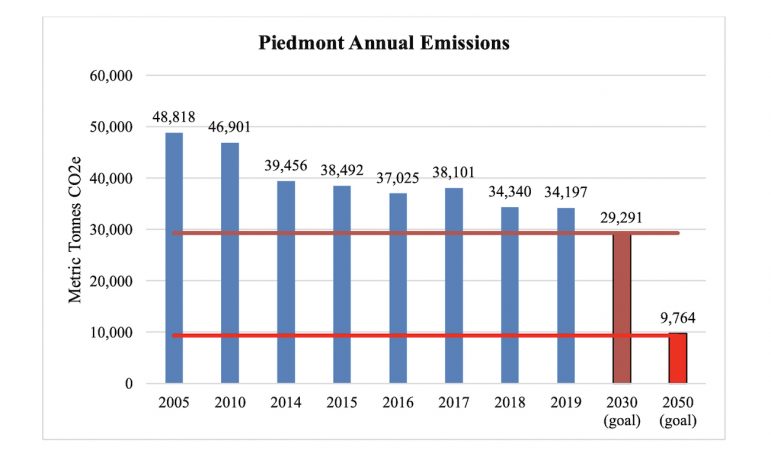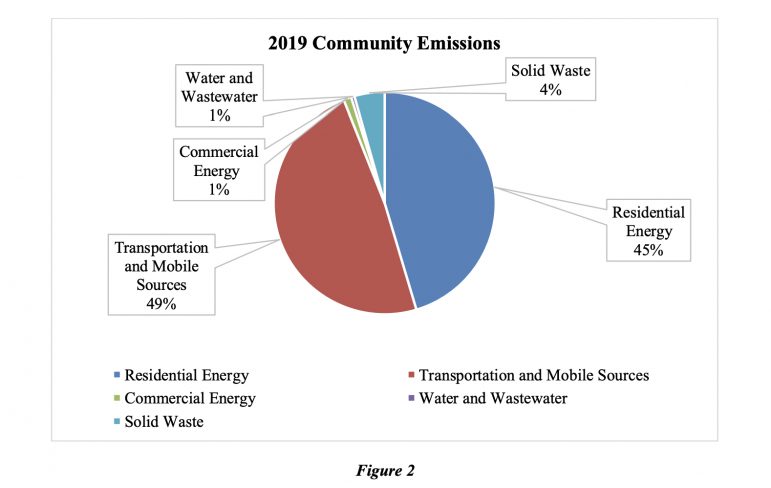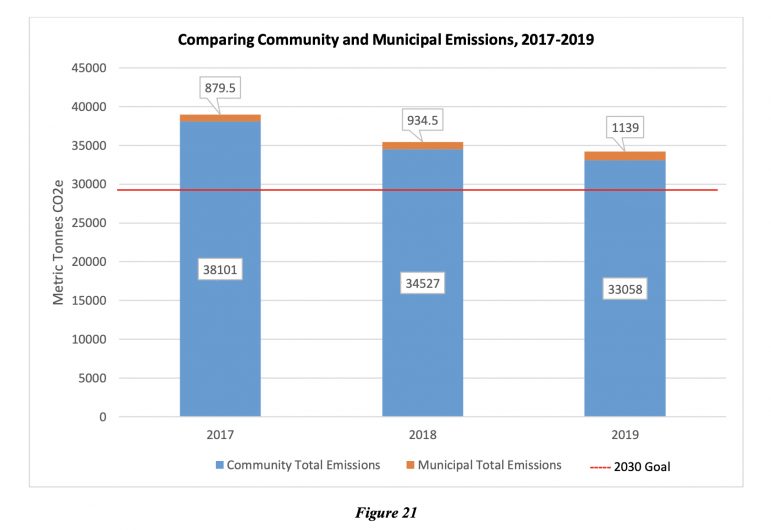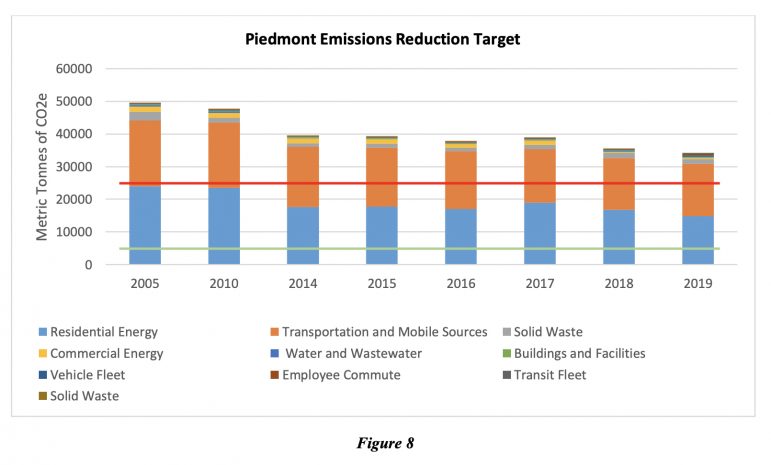
Having already taken several significant steps to cut greenhouse gas emissions, Piedmont officials say it will require more and bolder actions over the next several years to meet the city’s ambitious reduction goals.
Establishing a city “climate fund” to help pay for things like helping residents (especially low-income residents and renters) make the switch from natural gas to all-electric appliances, stepping up community outreach about the importance of shrinking the city’s carbon footprint and how to help do it, and bold steps like approving a “net zero” emissions in-fill housing development in the coming years are among the actions the city could take to meet emissions goals for 2030 and for 2050.
“Actions considered to be ‘low-hanging fruit’ have already been taken,” Alyssa Dykman, Piedmont’s sustainability program manager, told the City Council on June 21. “Further action is needed for the city to be on track to meet its cap goals.”
Those greenhouse gas emission reduction goals are spelled out in Piedmont’s Climate Action Plan 2.0, adopted in March 2018. Using the city’s 2005 emissions as a benchmark level, the plan calls for reducing that number by 40 percent by 2030, and by 80 percent below 2005 levels by 2050.
While Piedmont’s greenhouse gas reductions from 2005 to 2014 were substantial, about 23 percent, those reductions from 2014 to 2019 were about 15 percent. Dykman said that rate needs to go up.
“There’s going to need to be a large shift in emission reduction to meet the city’s 2050 goal,” Dykman said as part of an annual report to the City Council on the status of Climate Action Plan progress.
Nate Redinbo, Piedmont’s 2020-21 CivicSpark Fellow and who helps the city work on environmental issues, said Piedmont staff calculates emissions by collecting data from PG&E, East Bay Community Energy (which provides much of Piedmont’s residential electric power), other agencies, and from city employees. Those numbers, Redinbo said, are then processed through a climate dashboard (https://icleiusa.org/clearpath/) to get inventory numbers. (Read the data in the full City Council packet report HERE).

Dykman said the two greatest sources of greenhouse gases in Piedmont, by far, are residential (45 percent) and transportation (49 percent). Internal-combustion engines account for almost all of the transportation emissions, while natural gas heating and appliances account for the lion’s share of the residential emissions.
Redinbo cited the city’s establishment of “reach codes,” a series of development-oriented measures to bring energy savings and reduce natural gas use in Piedmont, and the requirement of home sellers in Piedmont to provide a Home Energy Score or a Home Energy Audit as key moves toward long-term emissions reductions. Both measures were adopted in February. Also, during 2018 and 2019, 93 percent of Piedmont’s electrical customers enrolled in East Bay Community Energy’s 100 percent renewable energy service plan. Piedmont’s hiring of Dykman in November was cited as another significant commitment to the city fulfilling its Climate Action Plan.
But more has to happen, Dykman and Redinbo told the council, to meet ambitious future goals.

As Figure 21 indicates, community emissions dwarf municipal emissions. But more needs to be done on both sides, especially to curb natural gas emissions and gas powered vehicle use. 
The chart shows Piedmont emissions from the past years and the current in-territory emissions goals laid out in the CAP 2.0: to reduce in-territory emissions to just 29,291 metric tons of Carbon Dioxide equivalent (CO2e) by 2030, and just 9,764 metric tons of CO2e by 2050. The red line indicates the 2030 goal and the green line indicates the 2050 goal.
“Until we radically reduce the use of gas-powered vehicles and of natural gas use in the home, we will not see a large reduction in carbon emissions,” Redinbo said.
Councilwoman Betsy Smegal Andersen asked how the city is going to account for an expected population jump in the next decade or so. The Association of Bay Area Governments, as part of the Bay Area’s Regional Housing Needs Allocation process, is being asked to plan to accommodate almost 600 new residences by the end of 2031, and that will likely add to greenhouse gas emissions.
Piedmont resident Randy Wu suggested that future housing stock could include a planned “net zero emissions” development. Acknowledging the city could make accessory dwelling units a key element in meeting that housing need, Wu said ADUs ought to be metered separately from their accompanying main residential structures.
“Piedmont could really lead the way on this,” said Wu, who suggested that Piedmont’s affluence could help usher in needed changes faster.
Enacting aspects of the city’s Pedestrian and Bicycle Master Plan to encourage more bicycle use and more walking would also help this campaign, council members said, as would establishing an eBike program in the city. Councilwoman Jen Cavenaugh said that along with “carrots,” like financial incentives, “sticks” such as energy taxes might be appropriate.
Mayor Teddy Gray King questioned a stigma against people hanging clothes out on a line and letting the sun and the wind dry them naturally. It would be good, King said, for Piedmonters to forego using their home clothes dryers.
“Can we do something to change that (stigma) rather than be embarrassed about hanging your towels outside?” King asked. “Can’t we make it something we’re proud of?”
Councilwoman Conna McCarthy asked how Piedmont’s results in reducing greenhouse gas emissions compare with those of other cities. Dykman said it’s tough to make direct comparisons.
“This is a new frontier for everybody,” Dykman said. And emissions, she added, aren’t bound by city and county borders.
“This is something on a larger regional scale, a global scale, that we’re going to have to work to address.”
Contact Sam Richards at sam.richards4344@gmail.com